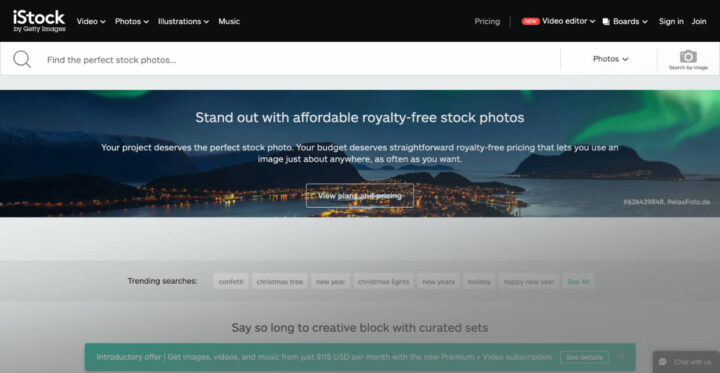Are you a photographer looking to monetize your skills? iStock is an excellent platform to showcase your work and earn money. Whether you're a hobbyist or a professional, selling your photos on iStock can be a rewarding experience. In this post, we’ll explore who can contribute to
Understanding iStock's Contributor Program

iStock, part of the Getty Images family, offers a vibrant marketplace for stock photography. It's designed for photographers, illustrators, and videographers who want to share their creativity while earning income. Here’s what you need to know about the contributor program:
Who Can Join?
- Photographers: Whether you're a seasoned pro or a passionate amateur, you can contribute your photographs.
- Illustrators: If you create illustrations or digital art, iStock welcomes your unique creations.
- Videographers: High-quality video clips are also in demand, so videographers can join too.
- Global Participants: iStock accepts contributors from around the world, making it a truly global platform.
Contributor Requirements
To become a contributor on iStock, you’ll need to meet specific requirements:
- Quality Content: Your photos and videos must meet iStock’s quality standards. This means clear images, proper lighting, and no excessive noise.
- Original Work: You must own the rights to your work. If it includes recognizable people or private property, you’ll need model or property releases.
- Technical Skills: Familiarity with photography techniques and editing software can significantly enhance the quality of your submissions.
- Account Setup: Creating an iStock account is straightforward. You’ll need to provide personal information and tax details.
Getting Started
Once you meet the requirements, you can start uploading your content. Here’s a quick rundown:
- Create an Account: Sign up on the iStock website.
- Upload Your Work: Use their intuitive upload tool to submit your photos, illustrations, or videos.
- Tag and Title: Properly tag and title your work to increase visibility in search results.
- Wait for Approval: Your submissions will be reviewed to ensure they meet iStock’s quality standards.
In conclusion, iStock’s contributor program opens doors for photographers and artists alike. With the right approach and adherence to guidelines, you can turn your passion into profit!
Also Read This: Does iStock Offer Rights-Managed (RM) Images? What Buyers Should Know
3. Eligibility Criteria for Photographers

If you’re considering selling your photos on iStock, the first question that comes to mind is, “Am I eligible?” The good news is that iStock welcomes photographers from various backgrounds and skill levels! Here are the key eligibility criteria to keep in mind:
- Age Requirement: You must be at least 18 years old to become a contributor. This ensures that you can legally enter into contracts, which is essential for selling your work.
- Legal Ownership: You need to own the rights to the photos you want to submit. This means all images should be your original work, or you should have secured the necessary permissions if they include identifiable people or private properties.
- Quality Standards: iStock has specific quality guidelines. Your photos should be clear, well-composed, and technically sound. This includes proper exposure, focus, and resolution. Aim for high-quality images that can compete in a global marketplace!
- Content Relevance: Consider what’s currently trending in the stock photography market. iStock often looks for content that is relevant to their audience’s needs, like lifestyle imagery, nature, business concepts, and more.
By meeting these criteria, you set yourself up for a successful experience on iStock. Remember, even if you’re just starting out, there’s a place for you as long as you’ve got a passion for photography and a willingness to learn!
Also Read This: How to Access My iStock Download History
4. Steps to Become an iStock Contributor

Ready to dive into the world of stock photography? Here’s a straightforward guide to help you become an iStock contributor:
- Create an Account: Start by visiting the iStock website and signing up for an account. You’ll need to provide some basic information, including your name, email address, and a password.
- Application Approval: After registering, you’ll need to submit a contributor application. This usually involves providing a few samples of your work. Don’t stress! Choose pieces that showcase your style and technical skills. iStock reviews your application to ensure you meet their quality standards.
- Familiarize Yourself with Guidelines: Once approved, take the time to read through iStock’s contributor guidelines. This document is crucial! It covers everything from technical requirements to release forms for models and property.
- Upload Your Work: Now comes the fun part! Start uploading your photos to the platform. Make sure to tag and describe each image accurately, as this helps potential buyers find your work. Use relevant keywords and think about what customers might search for.
- Track Your Progress: After uploading, keep an eye on your portfolio’s performance. iStock provides analytics that show how your images are selling. This can help you understand what types of content resonate with buyers, guiding your future shoots.
Becoming an iStock contributor is an exciting journey that opens doors to selling your photography worldwide. With passion, practice, and persistence, you can turn your creative hobby into a profitable venture!
Also Read This: How to Sell Your Images on iStock: A Step-by-Step Guide for Beginners
5. Quality Standards for Submitted Photos

When it comes to selling photos on iStock, quality is king! The platform has strict quality standards to ensure that the images available meet professional expectations. Here’s what you need to keep in mind:
- Resolution: Your photos should be at least 1,500 pixels on the shortest side. Higher resolutions are preferred, as they allow for greater flexibility in use.
- Focus: Ensure your images are sharp and in focus. Blurry or out-of-focus images will likely be rejected.
- Exposure: Proper exposure is crucial. Avoid images that are too dark or overly bright. Aim for a balanced exposure that highlights your subject.
- Composition: Good composition is essential. Use the rule of thirds, leading lines, and other compositional techniques to create visually appealing images.
- Noise: Keep noise to a minimum. Grainy images can detract from the quality and professionalism of your work.
Moreover, iStock emphasizes the importance of originality. Your photos should not only be technically sound but also unique and creative. Stock photography is abundant, so finding a fresh perspective can help your images stand out.
Lastly, familiarize yourself with iStock’s submission guidelines. They provide detailed requirements that can help you understand exactly what is expected. It’s worth investing time in learning these standards to improve your chances of approval!
6. Tips for Success as an iStock Contributor
Becoming a successful iStock contributor is not just about uploading great images; it's about understanding the market and continuously improving your craft. Here are some actionable tips to help you thrive:
- Research Trends: Stay updated on current trends in stock photography. Check iStock’s most popular categories and see what types of images are in demand. This can guide your photography sessions and help you create relevant content.
- Diversify Your Portfolio: Don't focus on one specific niche. While it's great to have a specialty, offering a variety of images can increase your chances of sales. Consider different themes, subjects, and styles.
- Optimize Keywords: Use relevant and specific keywords when uploading your photos. Think about what buyers might search for and include those terms in your metadata. This makes your images easier to find.
- Engage with the Community: Participate in forums or social media groups of fellow contributors. Sharing experiences and tips can provide valuable insights and may lead to collaborations.
- Keep Learning: Photography is an ever-evolving field. Invest time in learning new techniques, experimenting with different styles, and enhancing your post-processing skills. Online courses and workshops can be incredibly beneficial.
Finally, don’t get discouraged by rejections. Use them as learning opportunities. Analyze the feedback and improve your future submissions. Persistence is key in building a successful portfolio on iStock!
 admin
admin








